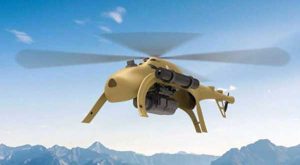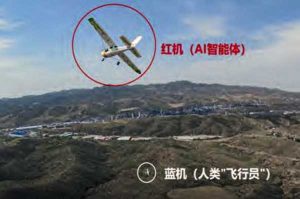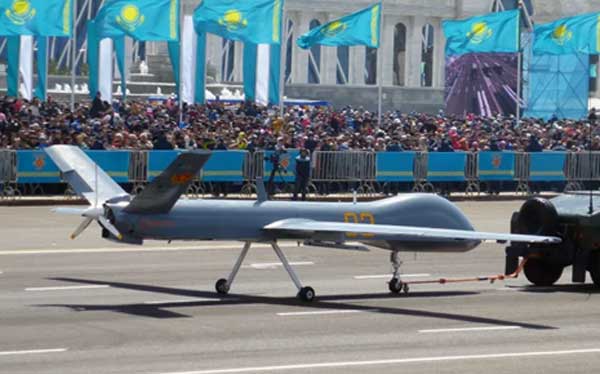In 2019, Global Times published an article on possible use of Artificial Intelligence (AI) in its drone programme. It was then believed by Chinese military experts that integrating AI with drones to make these as ‘fighter drones’ was possible and that it would allow them to “fly on their own, identify targets and take decisions to enhance their combat capability.”[1]
Today China is reportedly the leading country in drone swarm technology and fielding AI driven drones.
The Chinese were looking at developing the capability to enable the drones to fly intelligently, have smart situational awareness, capable of identifying targets and automatically modify some decisions.
Two areas of concern were identified. Firstly, the possible jamming of the drones that could render the drone non-operational and secondly, the lag caused by data transmission from the control stations. The latter was critical in a rapidly changing air situation wherein any lag in control data would prove fatal for the drone.
The safety concerns were also planned to be addressed to ensure that the drone strictly followed human commands and did not take any “unwished commands.”
An interesting point to note was that China was aiming to develop drones that could “fit into a whole combat system and exponentially boost the system’s combat capability.” Though the article did not give any details of the same, it was apparent that planned development was for manned-unmanned teaming and drone swarms.

The Blowfish A3, a helicopter drone equipped with a machine gun, developed by a Chinese defence contractor Ziyan UAS. Image: Ziyan UAS
Much water has flowed down the Yangtze since then and today China is reportedly the leading country in drone swarm technology and fielding AI driven drones. It is already adding AI to its Wing Loong fleet of attack drones and is competing with United States in this domain.
The Pentagon’s 2023 Military and Security Developments Involving the People’s Republic of China specifies the PLA’s “intelligentization” of warfare as intended to better “network” and “integrate” data nodes across a multi-domain force. United States acknowledges that China is pursuing “greater autonomy for unmanned aerial vehicles to enable manned and unmanned teaming and swarm attacks.” A look at recent training events show that manned-unmanned teaming (MUM-T) is already a standard part of training.
The Hongdu GJ-11 resembles a tiny B-2 stealth bomber and is believed to be able to fly at speeds up to 621 mph and can deploy precision munitions on targets.
Meanwhile, Global Times described what it refers to as the “intelligentization” of its Wing Loong drones with specific references to AI, “networking” and “autonomous” flight. The report described future operations of its Wing Loong drones as including “5G+,” “industrial internet,” and “artificial intelligence.” Some reports call these efforts as an attempt to merely replicate US in integrating AI with its own UAV programmes, especially the Loyal Wingman and the Grey Eagle programmes. [2]
Wing Loong 2can be remotely controlled by a human operator. Fitted with infrared cameras and sensors, the Wing Loong 2 can be used to keep supply lines under surveillance or to conduct strike attacks. The Wing Loong ID, a larger version of the Wing Loong 2 has been designed for endurance missions. This sizable unmanned air craft has a wing span of 58 feet and is designed for search and rescue as well as combat. It needs a half-mile runway to take off but can spend 35 hours in the air.
Wing Loong is not the only AI powered drone with China and it has many an ace up its sleeve. Other drones include the Caihong 4 (CH-4), which was developed by the China Academy of Aerospace Aerodynamics. It can be used for either reconnaissance or attack purposes, and resemble the U.S.-made MQ-9 Reaper.
The Hongdu GJ-11 resembles a tiny B-2 stealth bomber and is believed to be able to fly at speeds up to 621 mph and can deploy precision munitions on targets. It is also being used in conjunction with the Chengdu J-20 fighter jet – as a Loyal Wingman. Another UAV is the EA-03 Xianglong or ‘Flying Dragon,’ which has a body similar to the U.S. Global Hawk unit.

China’s AI-controlled aircraft (in the red circle) defeated another aircraft remotely-controlled by a human pilot in close-range air combat. Image: China Aerodynamics Research and Development Centre, Mianyang
All these give China an edge over its adversaries that may prove to be decisive in any future conflict, or a stand-off,
The rapid strides made by China in this field were revealed in a report published in March 2023, when South China Morning post reported that AI-Controlled Drone Outsmarted Human-Operated UAV in a test.
The AI controlled drone reportedly showed superior performance in cutting-edge close-range fighting and kept the human opponent a constant underdog even as the human-controlled machine made the first move to gain the upper hand.
The Nvidia chip enabled the AI pilot to make 1,000 decisions every second and was found to have worked satisfactorily,
The AI, apparently predicting his intention, outmanoeuvred the opponent, made a counter move and stuck close behind its opponent. The human-controlled aircraft dived to lure the machine to crash to the ground. The AI then moved to an ambush position and waited for the opponent to pull up. The human pilot tried other tactics such as “rolling scissors” – a sudden slow-down and change of course – hoping the AI would overshoot in the chase. The simulation was called off by the team after about 90 seconds because the human controller could not evade its AI opponent.[3]
Despite progress made by China in integrating AI, some challenges remain. Limited computing resources on an aerial vehicle, as opposed toa ground- based system, is one constraint. The greater complexity of air combat confrontation coupled with high dynamics, strong real-time characteristics and a larger solution space make developing a system capable of reacting in such an environment a very complex process.
Developing AI systems by China faces another hurdle in terms of access to more advance AI chips. The Chinese team had used an Nvidia Jetson TX2 module in the plane as the AI brain during its test. The Nvidia chip enabled the AI pilot to make 1,000 decisions every second and was found to have worked satisfactorily,
Though this particular Nvidia Jetson series is made in China and was thus available for use by the Chinese team. The export of more powerful AI chips to Chinese users is however banned by the US Government and thus not available to China. Developing an advanced chip is a challenge that China needs to overcome, though given its past record of gaining access to advanced technology, using all means, it will not prove to be an unsurmountable task.
With China being the largest producer, and exporter, of drones there is always a possibility of these drones falling into the hands of states/non-state actors hostile to China and using the Chinese drones against China itself.
One possible way forward for China would be continue working with Europe in the field of AI. Between 2017 and 2022, European researchers published more than 16,000 AI-related papers with Chinese colleagues based at institutions and universities either directly controlled by, or closely tied to, the Chinese military. Though concerns over the human rights abuses, technological competition and the risk of an invasion of Taiwan remain, Europe continues to engage with China.
Bundeswehr University Munich, carried out a study in collaboration with a People’s Liberation Army university on AI work that could help build automatic targeting systems. Other studies include work on “integrated missile guidance” and drone “Target Tracking Method Based on Deep Reinforcement Learning”.[4]
An associated issue is that of safety. Not only of a possible “mis-use” of armed drones but also that of the use of Chinese drones against China. With China being the largest producer, and exporter, of drones there is always a possibility of these drones falling into the hands of states/non-state actors hostile to China and using the Chinese drones against China itself. There are reports that China has developed that a secretive piece of hardware to safeguard against such use, and to prevent drones manufactured in the country from being used to attack China.[5]
Another option to restrict, or control their use is to limit the use of AI in armed drones. Media reports in November 2023 talked of a possible agreement to limit use of AI in drones by China and United States. A report by the South China Morning Post said that US President Joe Biden and his Chinese counterpart Xi Jinping “will enter into an agreement to limit the use of artificial intelligence (AI) technologies in military weapons and equipment” when they were to meet on the side-lines of the Asia-Pacific Economic Cooperation summit.[6]
There may not have been clarity on the way forward by US and China but what is patently clear that use of AI in drones, including armed drones, is a reality that cannot be wished away…
Like all such talks and proposed agreements, the summit ended without any agreement on limiting use of AI and all that was agreed to was to set up a formal government-to-government discussions on the technology with no clarity on the form or substance of the discussions held. Even the statements by the two sides were dissimilar. US stated that the two leaders “affirmed the need to address the risks of advanced AI systems and improve AI safety through U.S.-China government talks’ while China was vague about the talks and only listed AI as an issue where the governments should cooperate through existing or new government channels.[7]
There may not have been clarity on the way forward by US and China but what is patently clear that use of AI in drones, including armed drones, is a reality that cannot be wished away and that its use will only increase in the days to come. It cannot be wished away and vague promises of limiting it will not rein in the genie that is already out and about.
With China making rapid progress in this, it is time to hit the drawing boards and find ways to counter the growing threat. And the time is NOW.
Reference:
[1]Liu Xuanzun, “China’s fighter drones possible with AI use: experts”, Global Times, 14 August 2019
[2]Kris Osborn, “China Adds AI to its Wing Loong Fleet of Attack Drones”, Centre for Military Modernization, 13 Dec 2023
[3]Stephen Chen, “AI pilot beats human in landmark real-life dogfight, Chinese military researchers report”, South China Morning Post, 2 March 2023
[4]David Mathews, “Europe still working with China on military and surveillance uses of artificial intelligence, report finds”, Science Business, 21 Nov 2023
[5]Bob Wodecki, “Flying Dragons and Sharp Claws: China’s AI-Powered Military Drones”, AI Business, 23 August 2023
[6] Igor Patrick, “Biden, Xi set to pledge ban on AI in autonomous weapons like drones, nuclear warhead control: sources,” South China Morning Post, 11 Nov 2023
[7]Yukong Huang, “Three Takeaways from the Biden-Xi Meeting”, Carnegie Endowment for International Peace, 16 Nov 2023





